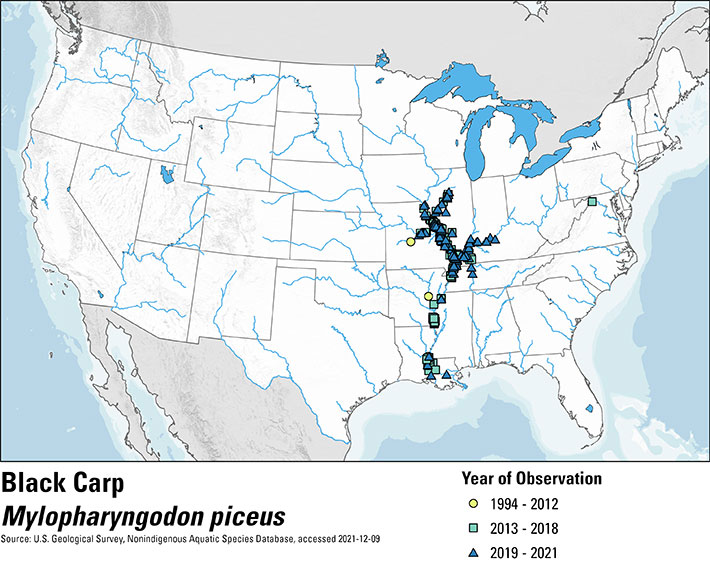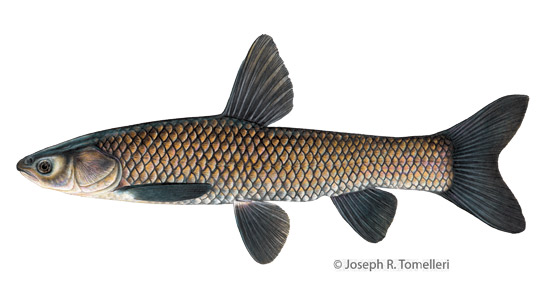Black Carp
Mylopharyngodon piceus
Fast Facts
Origin
Large rivers and lakes in eastern Asia from southern Russia to southern China and Vietnam.
Diet
Young feed primarily on zooplankton and later on insect larvae and detritus. Adults feed on mollusks.
Life Span
15 years
Size
Maximum of up to 150 pounds and 5 feet in length.
Historical Occurrence
 Historical occurrences of black carp in the United States. Data from the U.S. Geological Survey Nonindigenous Aquatic Species database, December 2021, represent reported observations of black carp, but populations may not be established in all mapped locations.
Historical occurrences of black carp in the United States. Data from the U.S. Geological Survey Nonindigenous Aquatic Species database, December 2021, represent reported observations of black carp, but populations may not be established in all mapped locations.
See current black carp occurrence data on the U.S. Geological Survey NAS database »
Resources
Black carp identification video. U.S. Fish and Wildlife Service. September 10, 2019
Read Keep, Cool, Call: What to do if you capture a black carp »

Background
Black carp were imported into the U.S. in the early 1970s, likely in conjunction with the importation of other invasive carp species. Black carp grow to relatively large sizes and live longer than other species of invasive carp. As a molluscivore feeding on mollusks and snails, its preference is to occupy benthic or riverbed areas, making it a desired biological control agent for snail populations in aquaculture ponds. Because of its known feeding ecology, its escape into the Mississippi River raised significant concern among resource managers for the long-term health of the historical native mussels in the Upper Mississippi River basin, of which over 70% are already imperiled or extinct. Since 2007, black carp have been listed as "injurious" under the Lacey Act. They have been captured in at least seven states, with multiple occurrences of natural reproduction.
To provide additional focus on the emerging threat from this species, the Invasive Carp Coordinating Committee formed an interagency Black Carp Work Group in 2017 to identify priorities and strategies for key research, monitoring and control activities supported through the annual Invasive Carp Action Plan.
There is a bounty program, administered by Southern Illinois University and funded by Illinois Department of Natural Resources, to encourage reporting of black carp and provide specimens for research. For more information about the program, read Keep Cool, Call: What to do if you capture a black carp.
Physical Description
Black Carp are elongated, laterally compressed and have a pointed head with flattened anterior portion and small toothless mouth. Their body is brown to black in color, and bluish-grey to white on the belly, with a keel from the pelvic fins to the anal fin. The fins are darker brownish-black or black with lighter hues at the base, and large overlapping scales have dark edges giving a cross-hatched appearance.
Preferred Habitat
Black Carp prefer habitats in the lower reaches of rivers and lakes with spawning occurring in areas of high turbulence.
Diet
Young black carp feed primarily on zooplankton and later on insect larvae and detritus. Adult black carp feed primarily on mollusks, such as mussels and snails, using their pharyngeal (throat) teeth to crush the shells. They also eat freshwater shrimp, crawfish, and insects. At all life stages, black carp will compete for food with native species. In addition to decimating native mussel populations, black carp can also negatively impact native fish, turtles, birds, raccoons, otters, and muskrats, through competition for food.
Size
Black carp reach maturity in 4 to 6 years. They can typically grow to more than 3 feet in length and weigh, on average, 33 pounds. The fish can reach 5 feet in length and weigh up to 150 pounds.
